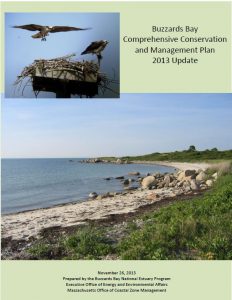2013 CCMP, Action Plan 1:
Managing Nitrogen Sensitive Embayments
About the new Buzzards Bay CCMP Action Plans
The Buzzards Bay Comprehensive Conservation and Management Plan (CCMP) was updated in November 2013 to reflect the great progress achieved since the original CCMP was finalized. You can download the entire document (buzzards-bay-ccmp-2013-update.pdf) or just this action plan nitrogen management action plan.
Managing Nitrogen Sensitive Embayments
Problem
Impairments to water quality and living resources caused by excessive nitrogen inputs to Buzzards Bay are one of the most pressing issues identified in this Buzzards Bay CCMP. Nitrogen total maximum daily load (TMDL) studies have not been completed for all embayments, but impairments are apparent in all the somewhat less well-flushed embayments that fringe Buzzards Bay. Loss of eelgrass beds, accumulation of benthic algae smothering shellfish beds, and low oxygen concentrations and resulting fish kills are among the impacts that must be remedied. Elimination of excessive nitrogen loads will ensure that all designated uses for those embayments are met. Wastewater discharges are typically the largest source in most watersheds. While state and federal agencies regulate permitted discharges like outfall pipes, some sources of pollution like cumulative loadings from septic systems are difficult to regulate. Solutions typically focus on municipal sewer expansion or nitrogen removing onsite systems, both of which have high costs.
Goals
Goal 1.1. Ensure that no designated uses will be lost, nor ecosystems adversely affected by excessive contributions of nitrogen to any area of Buzzards Bay.
Goal 1.2. Restore lost designated uses and adversely affected ecosystems impaired by the excessive contribution of nitrogen to any area within Buzzards Bay.
Objectives
Objective 1.1. To develop and adopt scientifically based nitrogen total maximum daily loads (TMDLs) for nitrogen impaired areas of Buzzards Bay.
Objective 1.2. To reduce the amount of nitrogen currently entering nitrogen-impacted embayments, including all areas identified on 303(d) and Integrated Lists, according to limits specified in approved TMDLs.
Objective 1.3. To ensure new additions of nitrogen to coastal waters do not cause, or contribute to, a violation of state surface water quality standards, or exceed federally approved TMDLs.
Objective 1.4. To ensure that state and federal discharge permits meet nitrogen loading limits and waste load allocations specified in approved TMDLs.
Objective 1.5. To promote the development and implementation of local plans to manage nitrogen sources to meet TMDLs and waste load allocations.
Objective 1.6. To promote the development and support the use of alternative and advanced nitrogen reducing wastewater treatment technologies at all scales of flow.
Objective 1.7. Monitor water quality and natural resources like eelgrass beds at a sufficient frequency to document management needs, assess the effectiveness of actions taken, and to document ongoing changes and variability in water quality and ecosystems health.
Approaches
Municipalities should take action to reduce nitrogen inputs to impaired waters. In most watersheds, sewering with disposal at centralized or satellite wastewater treatment systems with nitrogen removal will often be the most viable solution for reducing wastewater nitrogen inputs from areas with dense development. In less developed areas, advanced nitrogen removal onsite systems and small community scale systems may be part of a solution, as well non-structural alternatives. To ensure action, it is imperative that DEP develop, and for the U.S. EPA to adopt TMDL nitrogen limits and waste load allocations for all impaired areas. These limits only directly affect discharges requiring a federal permit, so municipalities must develop comprehensive strategies to manage all nitrogen sources to meet adopted TMDLs.
In some watersheds, better management of agricultural fertilizer release or manure management is needed. In the case of the cranberry bogs, nitrogen reductions can be achieved in part through various water use BMPs. Although typically a secondary source, stormwater dis-charges and residential fertilizer use can be locally important. All stakeholders should work closely with municipalities to reduce nitrogen to meet TMDLs, and implement comprehensive strategies, including managing or offsetting nitrogen inputs from new development.
Costs and Financing
Preliminary estimates by the Buzzards Bay NEP sug-gest that sewer expansion in the Buzzards Bay watershed may exceed $2 billion. Because of the costs and scale of the effort, meeting TMDLs will remain one of the most formidable political, financial, and management challenges facing municipalities in this CCMP. Implementation will likely take decades and require more state and federal support.
Measuring Success
The issuance of TMDLs, compliance with loading limits, and the area of impaired waters will be the man-agement measures tracked. Restoring water quality and recovery of habitat will be the long-term tracking measure. These will be assessed through the Coalition’s Water Quality Monitoring Program and the state’s eelgrass mapping and listings of impaired waters.
